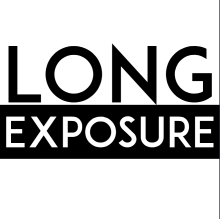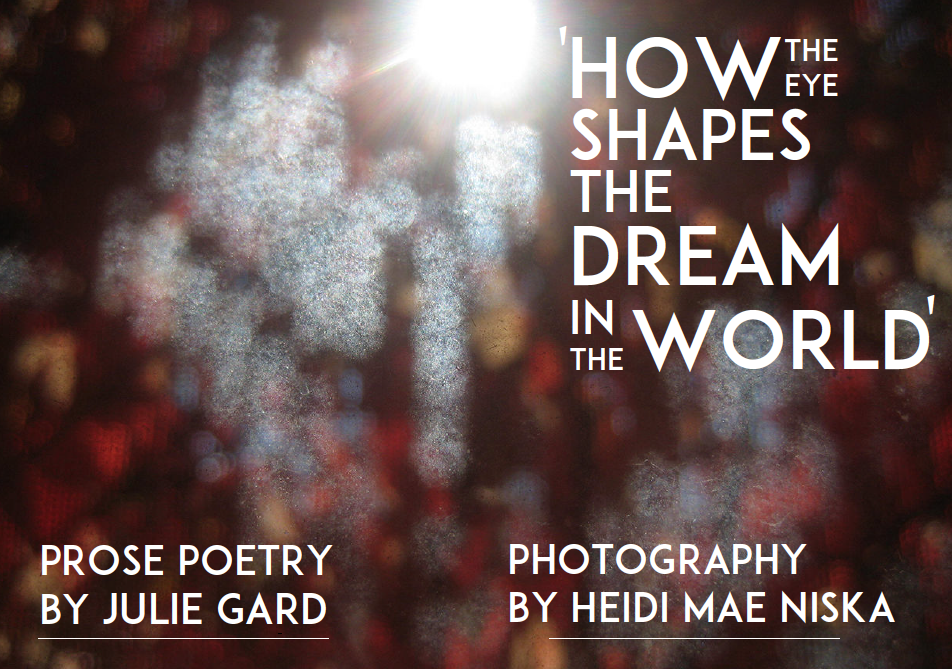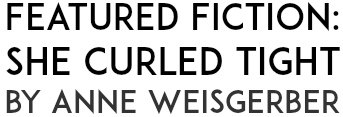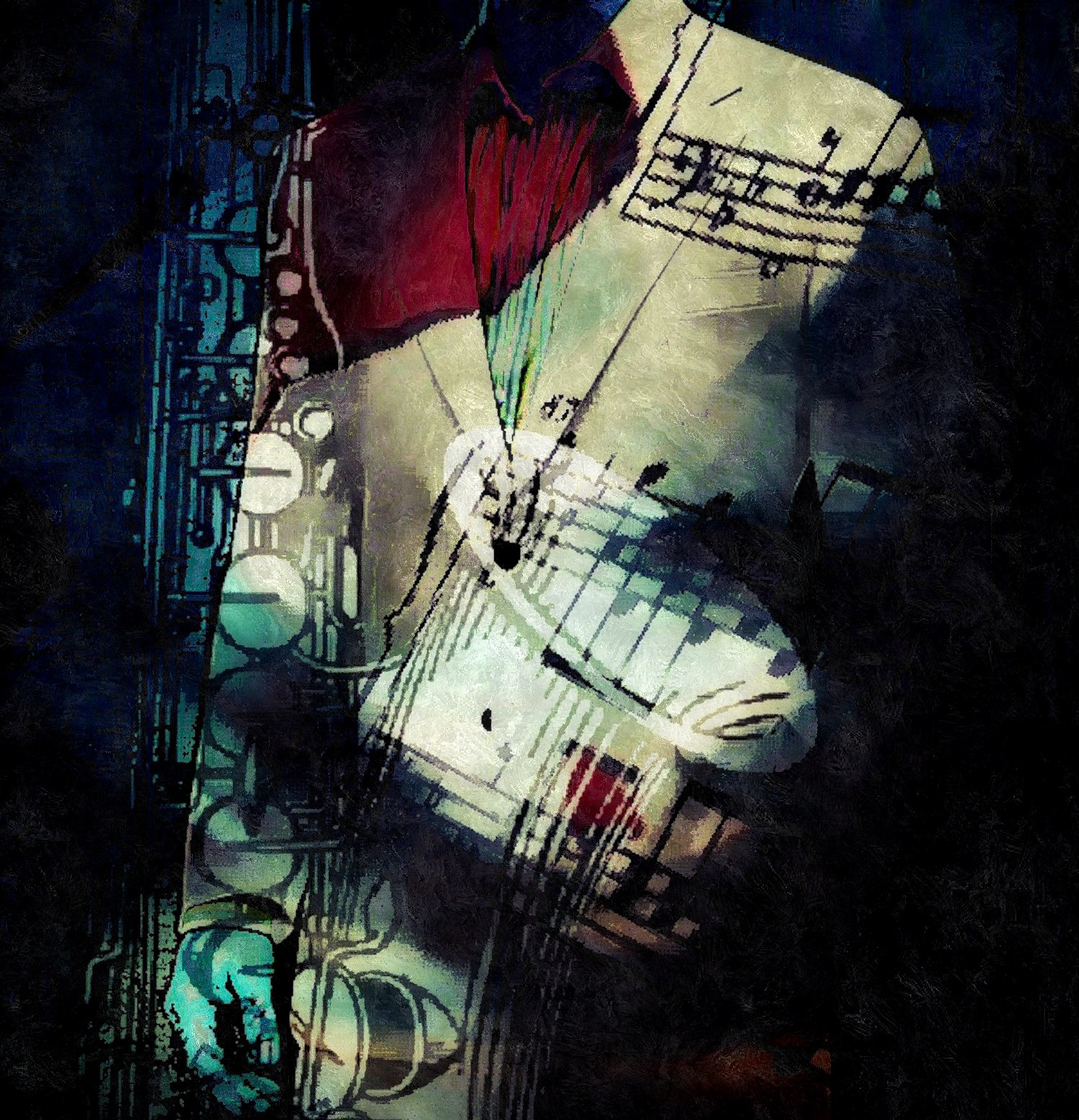
The art of Van Gogh and the sculpture of Louise Bourgeois inspire in these two new poems from Charlene Kwiatkowski.
Continue reading

Poetry | Fiction | Visual Art

The art of Van Gogh and the sculpture of Louise Bourgeois inspire in these two new poems from Charlene Kwiatkowski.

Heidi Mae Niska and Julie Gard reflect on their prose poem and photography collaboration set in northern Minnesota.

In this new poem, Lesley Burt explores the work of Van Gogh, discovering in it the possibility of a world ‘unclaimed by names’.

Northern Minnesota is the focus for these works, combining photography with prose poetry, itself a form which resists easy definition, to explore perception and the interaction of images and language.

Anne Weisgerber discusses and reads her flash fiction piece She Curled Tight for Long Exposure Magazine.
For more flash fiction like this, purchase Issue 4 of Long Exposure Magazine here.


‘At the end of each song he lays the saxophone on his lap, leans over and spits into a tin bucket. The floorboards under his chair are worn from years of heels tapping syncopated rhythms. His toe breaks through the sole of the boot, yet the shine remains jet black and sharp…’
Paul Rabinowitz reads his flash fiction piece Syncopated Rhythms for Long Exposure Magazine.
Art by Karen Boissonneault-Gauthier.
At the end of each song he lays the saxoph
Gabriel Rosenstock discusses the philosophy of Haiku and the ability of the form to disrupt everyday ways of seeing and thinking.
‘Emptiness’, his collaborative work with American Photographer Ron Rosenstock, is out now from Long Exposure Press.

‘The richness of this book lies not in any one person’s contribution, but in the fertile space between them – between word and image, between languages, between word and silence, between landscape and light.’

£4.99 (Digital Edition)
‘Through photography I have sought to explore the space between the finite and the infinite. For me, infrared photography is on the borderline, the veil between the known and the unknown … a search for what is beyond the doorway of perception. What draws me—what speaks to me—is the mystery …’
– Ron Rosenstock
Long Exposure Magazine has now been publishing for 2 years!
During this time the magazine has been fortunate enough to publish a fantastic range of poetry, photography, visual art and critical work from around the world. Many thanks to each contributor and reader who has been involved so far.
Issue 4 will add sharp and engaging short fiction to this output, featuring more writers and artists than any previous issue.
These are exciting times as we look to expand the magazine and above all promote high-quality creative work and those who are producing it.
Long Exposure Magazine is now offering feedback and guidance on a selection of your poetry. For an introductory fee of £10 you will receive rigorous feedback and editorial advice on a set of up to 5 poems through e-mail correspondence.
Editor Daniel Williams holds undergraduate and postgraduate degrees in literature and creative writing and has published poetry widely on-line and in print, including at Cadaverine, Ink, Sweat, And Tears, and Envoi. Alongside his work in editing and publishing, he has experience of teaching creative writing in a variety of contexts, from local community to university level.
Make your payment below and the editor will contact you to receive your work and begin your tutoring session. Any enquiries can be sent to editor@longexposuremagazine.com.
Further opportunities at Long Exposure Magazine.
Long Exposure is looking to put together a list of artists to work with frequently who can respond to the writing published in the magazine, through painting/illustration, photography and other visual art forms, to be featured alongside the creative writing pieces in each issue. This is an opportunity for regular publication and promotion. If you are interested in this project please contact editor@longexposuremagazine.com with a brief introduction and a sample of your work or links to some examples. You can see the type of work the magazine has published so far here.
For the next issue, Long Exposure is opening up submissions to fiction, specifically very short fiction of 700 words or less. In previous issues we explored traditional short forms such as the haiku (Issue 2), and how an economy of language and sharpness of observation can heighten the impact on the reader by using a minimum of words.
Definitions for this type of fiction are various, and as such our criteria are broad. Whether your pieces lean towards a fluid and poetic style or want to focus on delivering an engaging narrative in a tight space, we would love to read your work.
As usual we are open to poetry submissions on any style or theme, but with a particular interest in the Ekphrastic genre or work which combines text and image, as well as to photography and art work and collaborative projects between writers and artists.
See previous issues for the type of work we have published to date.
If you have an idea for an essay or article, particularly on the relationship between creative writing and the visual arts, contemporary poetry and poetics, or the arts in education and society, contact the author to discuss.
All submissions and enquiries to: editor@longexposuremagazine.com
We look forward to hearing from you!
The new edition of Long Exposure Magazine is now available!
Featuring an international selection of new creative writing, photography and visual art.
Access it here:
Long Exposure Magazine, Issue 3, July, 2016.




Window on the Garden
Memory, my dear Cecily, is the diary that we all carry about with us.
– Oscar Wilde
The coal tit is being purposefully
epigrammatic,
its terse flight from hedge
to bike handlebar,
and seemingly off
only to be back on the bike briefly.
So many false promises
of departure, playing
with finality like a conifer seed
in its nippy beak, it revels
in its mastery of reprieve
with flippant swerves,
in a black bow tie and wing collar,
it deflects
each drawn-out ending,
a sunflower seed
raided from a forgotten hoard.
Passerine bird
with three toes facing forward,
and one backward –
able to cling to the vertical
without falling out
of the picture,
you are impossible to frame. This urge
to cup you like a soft bollock and squeeze,
is wrong, in a nutshell
but your pithy nature;
the impossibility of boiling down
spirit into sweetmeat
makes a play of thwarted possession:
agog to count
the freckles on your eggs
in their nest in a mouse hole,
to pop one in my mouth
and keep it forever, far from teeth.
Mammogram
This sky ceiling has been kindly donated
by Patricia Madden Cancer Trust
Look up sister! Six blue squares,
but only one is clear, as cirrus clouds
permanently gather in the other five.
Look at the poster sister! A man
manages colour-coded strings,
so his gown doesn’t gape.
Look down sister! Flip
through a torn magazine.
See the ads: Breast Feeding is Best;
How to Enhance a Small Cleavage.
Look this nurse straight in the eye sister!
Smile. What are the odds you’re next?
Attention sister! All mammography patients
please remove deodorant or talcum powder
from the upper half of your body.
Look sister! If you have sensitive
breasts, this may hurt. Look up sister!
Outside, a black sky hangs open,
the moon impersonates a breast.
Family history told through
various sofas, hairstyles,
decorated pine trees;
children changing heights
to stand beside Santa in
different stores and towns;
one where, laughing, we all
strum inflatable guitars
brought home from Memphis.
One where, on the day,
I could not see that my mother
already looked like a ghost.
My son stands before me, facing away,
his shirt back straight, his posture
perfect.
I am afraid that when he turns to
face me, after dropping his rock in a
bucket half-full of water,
he will be
10,
20,
30,
and I will regret those
millennia in between.
A drop of water strikes a rock;
I see just how quickly the
surface changes,
but the substance beneath stays
the same.
And I am grateful for love.
Maybe now you can see the stars
leaning bright-tipped above your head.
And perhaps you notice how,
if you stitch them together,
they become glowing jump ropes,
the clouds as children
leaping and yodeling over arc shadows in a twilit park.
Sometimes we have to learn to love other things
and nature is what sutures,
what heals,
placing a palm on the middle of our back,
a bit like a demanding nurse
gently prodding, pushing and pulling us up on our feet
so that we might begin again.
Sometimes we have to choose others
which really just means loving ourselves first and foremost.
This is no rebuke, no judgment. There’s enough of that in the world.
But, Dear Son,
the noose and the blade are no one’s friend,
so please
please give them up for once.
If you can’t do it alone,
at least take my hand.
Here.
Good. Thank you.
Up we go now, off this bed and out that door
and into the night,
cool air on our skins,
crickets and stars and smell of weed grass everywhere.
Ah, through a cloud scarf
the moon has just this second peeked out,
perfectly pale and round.
Do you see it? Yes?
Won’t you take a step and stand where I’m standing?
Why don’t you get a really good look
and, if you think you can,
raise your voice and tell her
how beautiful she is.
Real Realism – An Art Manifesto for the Disenchanted
Mark Blickley is a widely published author of fiction, non-fiction, drama and poetry. His most recent book is ‘Sacred Misfits” (Red Hen Press) and his latest play, “Beauty Knows No Pain,” opens in November at NYC’s 13th Street Rep Theater. He is a proud member of the Dramatists Guild and PEN American Center.
Frie J. Jacobs is a Belgian visual artist, poet and composer. His 2015 credits include exhibiting at the international Art Festival Watou in Belgium, and the Brussels International Underground Poetry Festival at WIELS (one of the leading institutions for contemporary art in Europe). Along with participation in numerous group and solo art shows, he co-curated Project O, a roofless independent art project. Jacobs also composes music and soundscapes for video, and is a member of the international artist collective, Urban Dialogues.
Photography by Dairena Ní Chinnéide
Departure
Like shedding skin
fragments are packed up
shards of sanctuary disappear
the cottage dishes are washed
bags negotiate themselves
in a form of farewell.
I sit in this artists retreat
observing beauty peeking out of a Lidil’s bag
almost completed paintings
of a desire
as transitory as the brushstroke
the intentional randomness
of a splattered and empty easel.
Colours echo more than sound
or the potential of memory
from the artistry within us
swallowed gulps of gaiety
a whole moon on a shoulder
the palette of parting
still wet in cracks of stone.
Flying the Coop
flown coop,
a wall
between emptiness.
space expands
in this narrow
house
I do not inhabit,
just resting,
conjuring my nest.
aloneness
blares,
digitally enhanced,
oneness
breathes personality,
comet risen;
I blossom
by dim light
in my bed,
loverless,
ecstatically naked,
like water.
purified silence
delves in, I live alone,
alive.
The year is like a snake,
crawling through a field
tortuously toward its end.
Clouds like trucks roll
across the sky.
Stars burn in the void
of a black night, only to die.
My toenails are as long
as sabers. My hair
falls into my eyes.
Writing a poem is harder
than climbing a mountain,
or drinking from a dry fountain.
My face looks as old
as the Yellow River.
Only two months ago,
I felt like I was twenty-five,
when you were still alive.
For our next issue, Long Exposure Magazine is seeking photography or visual art based on the theme of ‘Movement’. The representation of movement, such as the play of light, the movement of animals or the actions of figures, have been a long standing preoccupation for the techniques of creative writing and the visual arts. The theme is open to new possibilities and can be interpreted in any way you choose.
A selected image or art work will then be chosen to feature as the front cover of Long Exposure Issue 3. Submissions to: editor@longexposuremagazine.com
As always, we look forward to viewing your work!
To view the type of work we have featured to date, read our previous issues here.
For the latest updates on the progress of the magazine and to view new content, support Long Exposure on social media:
Twitter: @longexposuremag
Facebook: Long Exposure Magazine
For Ezra Pound
il miglior fabbro.
(The better crasftsman.)
– T.S Eliot’s dedication, The Wasteland, 1922.
For some, the act of writing can be seen as highly individual, even solitary in nature.
However, with the amount of participation in creative writing courses of various types over the past several years, there is a definite engagement with the craft of writing, and the social element a course entails. Courses of this type cannot generate publishable work from scratch, but provide a space to present it, nurture interest and confidence, and sharpen talent and direction. We as writers can benefit greatly from this type of creative collaboration, a way of seeing our work from a fresh perspective and pushing its best qualities on to their full potential, much as Eliot and Pound displayed in the dynamics of their relationship.
Long Exposure Magazine’s team is offering rigorous one-on-one support online to provide guidance for poets at any stage of their careers, who are looking for constructive feedback and engaging ways to make further progress with their work.
Tutoring sessions and pricing are highly flexible. If you would like to be involved please send a small sample of your work to: editor@longexposuremagazine.com. Any further enquiries can be made to the same address. We look forward to hearing from you!
Insatiable Carrot by Judy Kendall (Cinnamon Press, 2015)
For many writers, the garden, as a natural environment partly shaped by the individual’s personality, has maintained a considerable attraction. W.H Auden writes in his poem ‘Moon Landing’, ‘…give me a watered, lively garden, remote from blatherers/about the New’, asserting a preference for the tangible, domestic space in place of man’s progress into new territory. Composed in the latter part of the poet’s life, the simplicity of looking out on a stretch of tended land he could call his own represented a retreat from the accelerated intensity of the modern world. It also provided a security Auden had rarely been afforded, a sense of belonging.
Judy Kendall, in turn, employs her poetry to articulate a connection with the land, how the tactile and physical work of maintaining a garden, and the attention this requires, can be channelled into poetry, and may in fact embody the same characteristics.
The poems form observations of the continuous processes of life happening outside ourselves, from the slow progress of growing vegetables to the shriek of an owl at night. Subsequently, many examples draw from features of the Haiku form, with a focus on individual moments of action or stillness. Movement and a sense of the dynamic are key throughout, with the text moving fluidly over the page, resisting constraints or predictability. Through this, Kendall communicates elements both of her gardening and writing processes, and the essential relationship between them. The division between human activity and the natural world, and the poet’s resistance to this, is succinctly but strikingly probed in the line:
‘garden house divide
civilization –
as thin as that?’
-From ‘V
erge’
Throughout there are experiments which offer new challenges to the reader in this immensely varied collection, displaying Kendall’s exploration into the use of visual poetry and typography, and increasing the reader’s engagement, as they become involved in bringing its nuances to the surface. There is a huge creative energy and vibrancy behind the work, and its range is broad, spanning lyric poems, such as traditional sonnets, one or two-line fragments, arrangements with a variety of fonts, and examples where the text is effectively double exposed in appearance, as in ‘A little hedge-cutting?’, where this innovation potentially mimics the vibration of operating an electric hedge trimmer.
As a result, the poems are ambitious in their desire not only to represent experience in language, but to communicate some of the fundamental elements of the activity or object observed through maximising the poems potential, and what can be achieved with the written word on the page. The text works to provide more immediate and multi-sensory data of the experience than a simple re-telling.
In this way the poems, through their innovation, suggest a return to the source, a quest to assist us in remembering our place in the interconnected and co-dependent environments we inhabit.
Daniel Williams
A selection of Judy Kendall’s work is included in Long Exposure Issue 2, you can access it here.
Purchase a copy of ‘Insatiable Carrot’ here.
you don’t have to be extreme
to be content,
other forces feed
this show-
they build on what has been
and mingle with consent,
then roam the rivers we invent-
using nature and nurture’s seed
to make it grow.
unshade your grey, reclusive hours
and play your made, profusive flowers
all the way:
don’t let regret upset your dream-
it’s all it’s light has been
and make what it empowers
from today.
but hark at me!
not knowing
what i’m sowing
day to day
deliberately-
and yet, i know it’s coming,
comes from going
out of me-
what i don’t make, i borrow-
come and see.
Bio: Strider Marcus Jones is a poet, law graduate and ex civil servant from Salford/Hinckley, England, with proud Celtic roots in Ireland and Wales. A member of The Poetry Society, his five published books of poetry are modern, traditional, mythical, sometimes erotic, surreal and metaphysical http//www.lulu.com/spotlight/stridermarcusjones1. He is a maverick, moving between forests, mountains and cities, playing his saxophone and clarinet in warm solitude. His poetry has been published in numerous journals and anthologies to date.
What is the answer
To that ancient problem?
Rain against glass,
The gutter’s low-
throated street song;
listen.
*
Every evening, he could measure progress
by the packed snow collected
under his boot-soles.
Finally, he unlaced them, loosening
stiff leather to stark flesh,
accepting the cold.
*
Razor slip- the water clouding red
like a prophecy; he traces the torn skin,
recognising himself in the mirror.
Conclusion follows question, indistinctly;
at the door, she shares the wound
like an old master.
*
In the house of words
he had assembled,
he wrote the sign
for ‘permanence’
as the house
trembled.
*
Starlings clustered
against the pier’s taut
skeleton,
the sea grinding shoreward,
its salt-tang resumed like a vow;
all one movement.
Bio: Daniel Williams is a poet and writer, and founding editor of Long Exposure Magazine.
Bio: an’ya is the haigo (haiku nom de plume) of Andja Petrovic. an’ya loosely translates to “a peaceful light in the moonless night.”
an’ya is cattails Principal editor for the United Haiku and Tanka Society (UHTS), and was voted one of the top ten haiku poets in the world by her peers in 2011.
She has won world-class awards and honors for her haiku and other verse forms from Japan, Canada, New Zealand, Australia, Germany, India, the UK, Brazil, and the Balkans.
Her work has been published in numerous international publications and anthologies. She and has been editor-in-chief of haigaonline, Moonset, the Tanka Society of America newsletter and the Haiku Society of America (HSA) 2011 anthology and is a winner of the HSA Merit Book Award. She is a founder and President of the Oregon Haiku and Tanka Society.